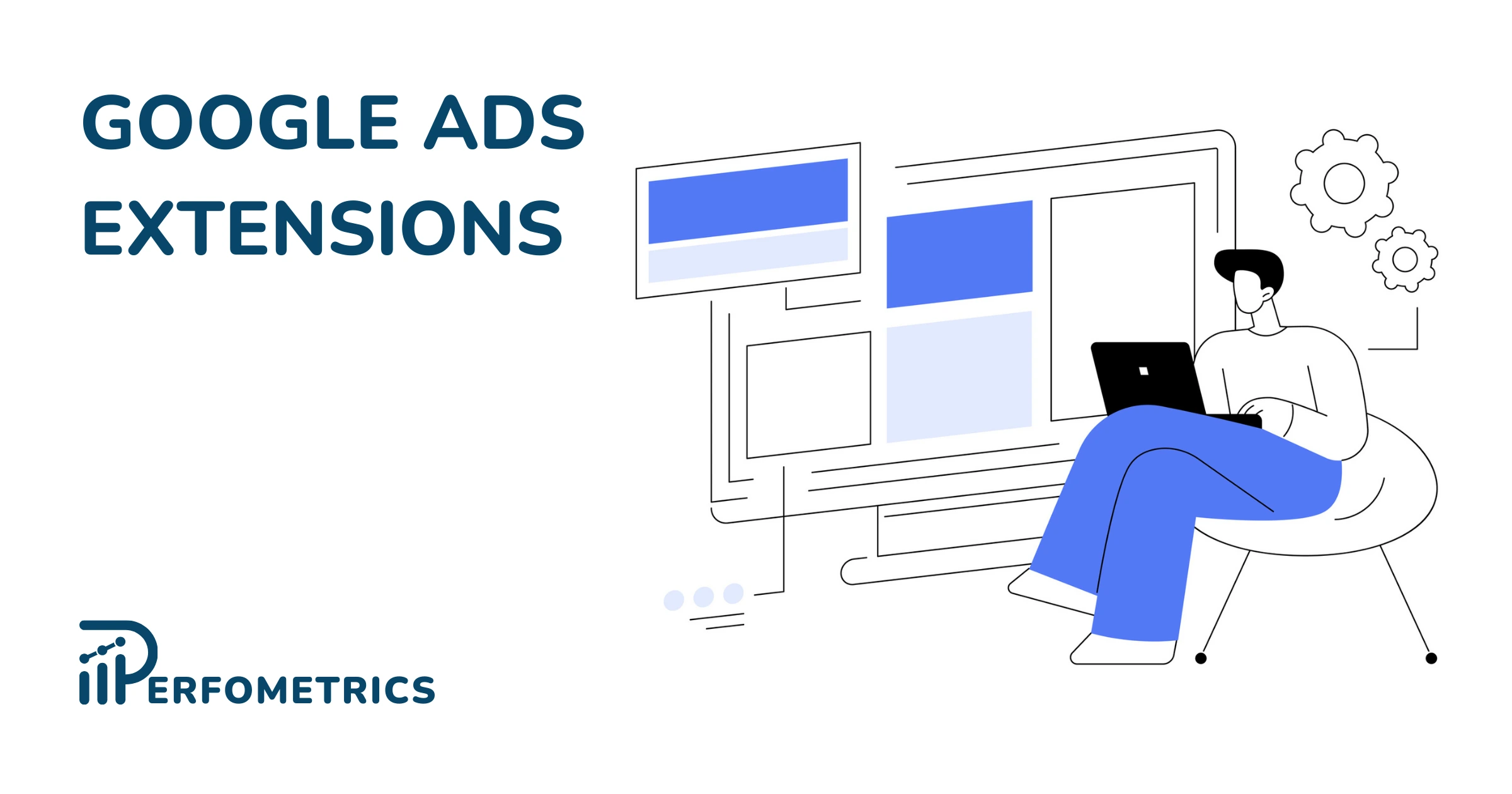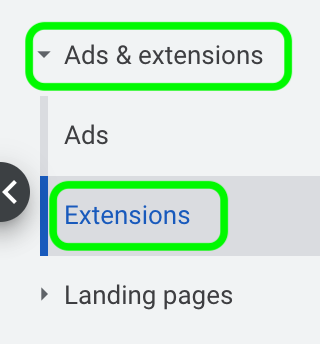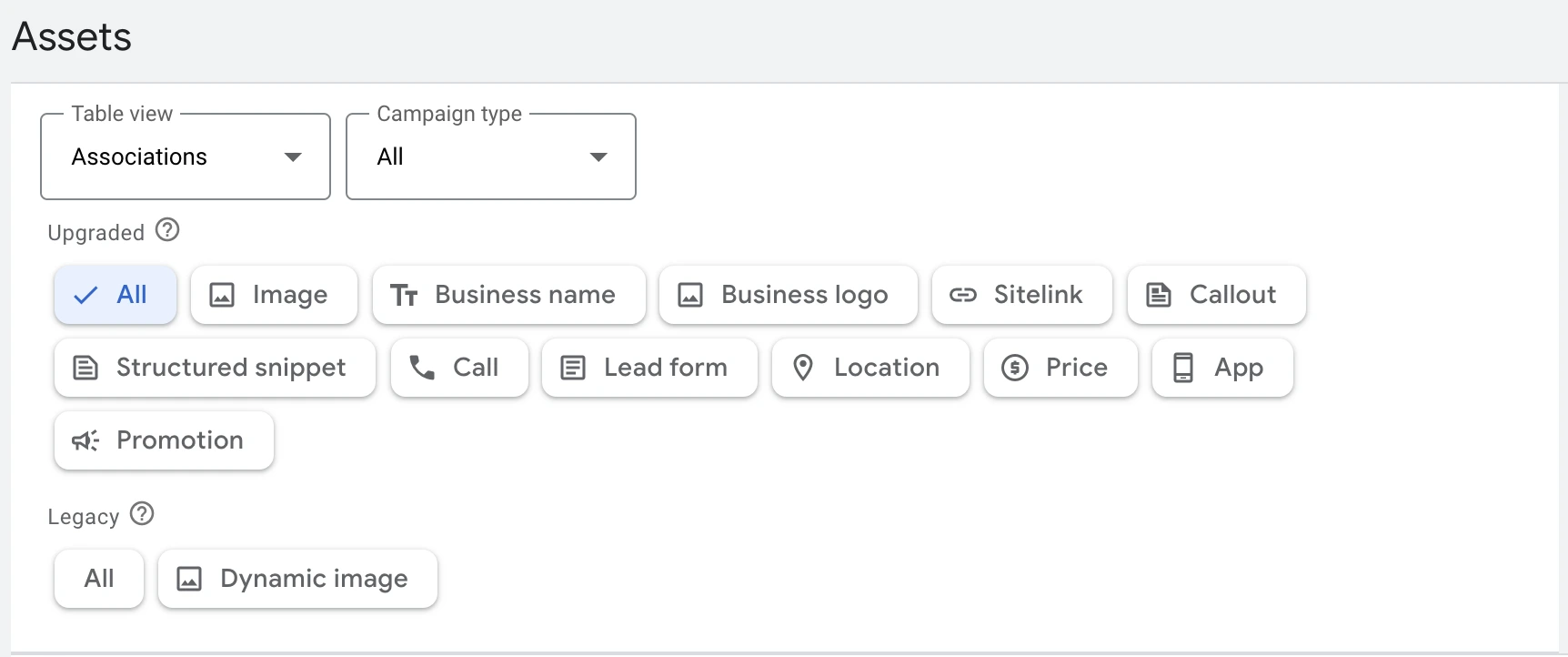Google Ads Extensions [Complete Guide] – All You Need To Know

To build a successful Google Ads campaign (or practically any other PPC platform) today you will need good-quality ads. In addition to the headlines and descriptions, you will also need to include ad extensions.
Google Ads extensions provide many benefits and are particularly useful, they serve many purposes and they can indeed have a positive impact on your performance. Google Ads extensions can transform your ads into highly engaging and informative marketing tools, driving more clicks, conversions, and ultimately, revenue.
Key Takeaways
- Google ad extensions are slots you can use to display additional information that is useful to your customer.
- There are many different ad extensions, review them carefully and pick the ones relevant to you.
- Not all Google ad extensions are made equal, some are more important than others and a lot also depends on your business.
- Google ad extensions are still quite limited, they aren’t all available for every campaign type and they don’t always show 100% of the time
- Stay proactive, it’s required of you to keep an eye on your ad extensions, update them, test new ones, experiment with new ideas, and also stay updated with what Google is rolling out
What Are Google Ads Extensions?
Google Ads extensions are add-ons to your existing ads, both for expanded and responsive ads. They serve as complementary information to your main headlines and descriptions. It’s an opportunity for you to show why customers should choose you and your business over the competitors.
Google Ads Extensions are customizable features that enhance the appearance and functionality of your ads, offering additional information and choices for users.
Ad extensions allow you to:
- Display additional information
- Link to relevant pages
- Share contact details
- Add call buttons
- Include location information
- Show product images
- Provide additional site links
You can set them up to be on the account level, campaign level, or even ad group level. This can be useful as some extensions are applicable across all of your campaigns and it’ll be easier to apply it on the account level instead of the campaign level and so forth.
Sitelink Extensions, for example, allow you to add various links to your ads, helping users navigate your website with ease. Meanwhile, Callout Extensions enable advertisers to incorporate brief snippets of text into their ads, emphasizing unique selling points or offers.
Why Should You Use Extensions in Google Ads?
Utilizing extensions in Google Ads can provide increased visibility, improved ad quality, and various opportunities for user engagement and conversion. Ad extensions can furnish more ad space, allowing you to showcase more information and add useful links, phone numbers, and other pertinent data to increase your conversions.
Google Ads predicts that ad extensions can improve ad performance and user engagement. The usage of these and other ad extensions aids in crafting engaging, informative advertisements that attract clicks and conversions. The likelihood of users clicking and converting increases with the level of information and engagement in your ads.
Can you use multiple ad extensions in a single ad group?
Yes, you can use multiple ad extensions in a single ad group to maximize user engagement and improve ad performance.
How do Google Ad Extensions Work?
Google Ad Extensions work by displaying additional information or options alongside your ads, depending on the type of extension used and the user’s device. Ad extensions, by offering more details before engagement, help in generating higher quality leads.
With the help of Google’s algorithms, ad extensions can be automatically generated or manually added, allowing advertisers to customize their ads and improve overall performance. By using manual ad extensions, advertisers can have more control over the information displayed alongside their ads.
How to track the performance of your ad extensions?
You can track the performance of your ad extensions by selecting the “Ad extensions” tab in your Google Ads account and viewing the performance metrics, such as impressions, clicks, and click-through rate (CTR). Monitoring these key metrics will help you gauge the effectiveness of your ad extensions.
How to Add Google Ads Extensions?
To add new Google Ads extensions follow these simple steps:
- Sign in to your Google Ads account
- Select Ads & Extensions
- Pick Extensions
- Click on the blue + button to add new ad extensions
(Note: think about the level you’d like your ad extensions to be applied at. You can set them to be on the account level, campaign, or even ad group level)


Types Of Google Ads Extensions
Ad extensions can take many forms and serve different purposes. There are two main categories, manual and automatic Google Ads extensions.
To make it simpler for you to easily keep track, learn the official guidelines from Google, and stay updated with the latest changes we have provided the links to each and every one of the ad extensions directly to the official Google documentation.

There are 11 manual Google Ads extension types:
- Sitelink extension
- Callout extension
- Structured snippet extension
- Call extension
- Lead form extension
- Location extension
- Affiliate location extension
- Price extension
- Promotion extension
- Image extension
- App extension
And there are 7 automatic (dynamic) Google Ads extension types:
- Dynamic Sitelink extension
- Dynamic Callout extension
- Dynamic Structured Snippets extension
- Automatic Location extension
- Business information
- Dynamic Image extension
- Seller ratings
11 Manual Google Ads Extensions
Sitelink Extensions
Sitelink Extensions offer direct connections to particular pages on your website, allowing users to quickly access the information they’re looking for. Sitelink Extensions provide the following benefits:
- Minimize the steps to reach the needed content
- Reduce friction and bounce rate
- Enhance user experience
- Encourage conversions
For optimal results, it’s recommended to add Sitelinks at the campaign or ad group level and link to pages related to the ad’s theme, such as pricing pages, testimonials, or free demos. Effective use of Sitelink Extensions can boost user experience and increase click-through rates.
Callout Extensions
Callout Extensions enable advertisers to incorporate brief snippets of text into their ads, emphasizing unique selling points or offers.
These extensions expand the size of your ad, providing you with an extra line of text that focuses on the benefits. Callout Extensions, by emphasizing key selling points, promotions, or other vital business information, can render your ads more appealing and informative.
To make the most of Callout Extensions, focus on numerical values and specifics that showcase your unique offers. The use of up to six Callout Extensions per campaign is permitted, allowing you to emphasize multiple aspects of your business.
Structured Snippet Extensions
Structured snippet extensions provide a concise overview of a business’s offerings, appearing adjacent to the ad description text. They support up to 10 25-character values, enabling you to showcase specific products or services to help users understand your offerings before clicking on your ad.
To effectively use structured snippet extensions, ensure that your snippets accurately represent your business and its offerings. Keep the link text concise and include descriptions for each value. By utilizing structured snippet extensions, you can effectively showcase your offerings and improve user engagement with your ads.
Call Extensions
Call Extensions enable searchers to quickly connect with your business via phone by displaying a click-to-call number in your ad for mobile device users. Implementing a call extension can facilitate easier access to a business for customers and typically yields more qualified leads.
To make the most of Call Extensions, it’s essential to monitor and address any incoming calls to prevent call abandonment. By allowing users to call your business directly from the ad, Call Extensions can increase the likelihood of conversions and improve overall ad performance.
Lead Form Extensions
Lead Form Extensions provide an opportunity for users to submit their contact information directly on the SERP, eliminating the need for filling out a form on the landing page. Lead Form Extensions, by simplifying the conversion process, can aid in generating qualified leads and speeding up the sales cycle.
You can collect information such as:
- Name
- Phone number
- City
- Zip code
- State
- Country
- Company name
- Job Title
- Work email
- Work phone number
To maximize the effectiveness of Lead Form Extensions, it’s essential to configure the questions and submission messages carefully and select an appropriate call to action. By providing a seamless conversion path, Lead Form Extensions can improve user engagement and drive more conversions for your business.
Location Extensions
Location Extensions provide your location information on its own line, assisting customers in finding your location(s), a map to your location, or the distance to it. By displaying your ads alongside a clickable map and your address, Location Extensions make it easy for users to find your business and visit in person.
Location Extensions are ideal for businesses that require in-person transactions, such as restaurants, retail stores, and service providers like barbers or beauty salons. By utilizing Location Extensions, you can increase the likelihood of physical visits and purchases, ultimately driving more revenue for your business.
Affiliate Location Extensions
Affiliate Location Extensions enable the selection of general retailers or auto dealers from a pre-selected list worldwide, to be appended to an ad. These extensions display the location of the nearest retail or auto chain to the viewer when they view your ad, helping users find nearby stores that sell your products.
Manufacturers that collaborate with major retail outlets typically utilize Affiliate Location Extensions to expand their retail reach. To make the most of these extensions, ensure that the selected chain consistently carries your products at all locations.
Price Extensions
Price Extensions enable businesses to set cost expectations in advance, promoting transparency, and aiding in the development of trust with searchers. Presenting your pricing upfront allows users to assess if your products or services fit their budget before they click on your ad.
Price Extensions offer clear advantages for businesses that offer dynamic pricing models, service packages or a wide range of products. They allow organizations to effectively differentiate their offerings and attract more customers.
By utilizing Price Extensions, you can foster transparency, create trust with searchers, and provide users with more information to inform their purchase decisions before arriving at your website.
Promotion Extensions
Promotion Extensions enable advertisers to:
- Highlight limited-time offers or discounts in their ads
- Draw in users looking for deals
- Enhance the overall appeal of your ad by highlighting sales and discounts.
To effectively utilize Promotion Extensions, consider using start and end date options for short-term deals. Alternatively, you might opt for the price or structured snippet extensions if your promotions are not time-sensitive. By leveraging Promotion Extensions, you can draw in bargain hunters and boost the overall performance of your Google Ads campaigns.
Image Extensions
Image Extensions provide enhanced visual appeal to your ads, thereby increasing engagement and attractiveness. Adding images to your ads can render them more engaging and visually appealing, potentially leading to increased click-through rates and better ad performance.
To make the most of Image Extensions, ensure that your images are clear, high-quality, and relevant to your ad. By incorporating visually appealing images into your ads, you can create a more engaging and memorable experience for users, ultimately driving more clicks and conversions.
App Extensions
App Extensions promote downloads for an app under the associated ad copy, increasing the visibility of your mobile app and encouraging users to download it. Featuring your app directly in your ad can increase the chances of users downloading and engaging with your app, leading to more installs and better app performance.
To effectively leverage App Extensions, ensure that your app is listed on iOS or Android, and then locate it to appear as an extension option. By incorporating App Extensions into your Google Ads campaigns, you can drive more app downloads and boost your mobile app’s visibility.
Automated (Dynamic) Google Ad extensions
Automated (Dynamic) Google Ad extensions are added by Google Ads to improve campaign performance without manual setup. These extensions include:
These extensions can be automatically generated based on information from landing pages, queries, historical data, and business settings, allowing advertisers to optimize their campaigns with minimal monitoring and configuration.
Dynamic Sitelinks Extensions
Dynamic Sitelinks Extensions provide an efficient way to direct users to pertinent pages on your website. By automatically adding relevant links and descriptions to ads based on a user’s search query, Dynamic Sitelinks Extensions allow users to quickly access the information they are seeking, thus improving engagement and click-through rates.
To effectively use Dynamic Sitelinks Extensions, ensure that your manually-added sitelink text is incorporated into your ads. By utilizing Dynamic Sitelinks Extensions, you can enhance user experience and boost click-through rates, leading to improved overall ad performance.
Dynamic Callout Extensions
Dynamic Callout Extensions display pertinent information from a landing page automatically, making your ads more informative and engaging. By displaying additional text assets alongside the search ads, Dynamic Callout Extensions help users gain more insight into the product or service, making the ad more informative and attractive.
To activate Dynamic Callout Extensions in Google Ads, follow these steps:
- Navigate to the desired campaign or ad group.
- Select ‘Ads & Assets’ from the page menu.
- Choose the ‘Assets’ dropdown in the section menu.
- Create callouts by adding additional text assets that provide more information about your products or services.
By using Dynamic Callout Extensions effectively, you can improve user engagement and drive more conversions for your business.
Dynamic Structured Snippets
Dynamic Structured Snippets are tailored to the user’s search query, displaying specific features or services. By showcasing particular aspects of products or services available, Dynamic Structured Snippets can enhance the visibility, ad rank, and performance of your Google Ads campaigns.
To effectively use Dynamic Structured Snippets, ensure that the snippets accurately represent your business and its offerings. By utilizing Dynamic Structured Snippets, you can effectively showcase your offerings and improve user engagement with your ads.
Automated Location Extensions
Automated Location Extensions enable users to easily identify the location of your business on a map and acquire directions to visit. By displaying your ads alongside a clickable map and your address, Automated Location Extensions make it easy for users to find your business and visit in person.
By utilizing Automated Location Extensions, you can increase the likelihood of physical visits and purchases, ultimately driving more revenue for your business. These extensions are ideal for businesses that require in-person transactions, such as restaurants, retail stores, and service providers like barbers or beauty salons.
Business Information
Business Information Extensions in Google Ads serve to provide potential customers with additional information about your business, including your business name, logo, and other pertinent details. By displaying this information in your ads, you can improve your ads and give customers more reasons to select your business.
To effectively use Business Information Extensions, ensure that the provided information is accurate and up-to-date. By incorporating accurate business information into your ads, you can create a more engaging and memorable experience for users, ultimately driving more clicks and conversions.
Dynamic Image Extensions
Dynamic Image Extensions are automated extensions that utilize pertinent visuals from your ad’s landing page to enhance your ad and make it more aesthetically pleasing. By adding relevant images to your ads, you can make them more engaging and eye-catching, potentially leading to higher click-through rates and improved ad performance.
To make the most of Dynamic Image Extensions, ensure that your images are clear, high-quality, and relevant to your ad. By incorporating visually appealing images into your ads, you can create a more engaging and memorable experience for users, ultimately driving more clicks and conversions.
Seller Ratings Extensions
Seller Ratings Extensions display a business’s positive ratings and reviews, creating trust with prospective customers. By showcasing your business’s high ratings and reviews, you can establish credibility and encourage users to click on your ad and engage with your business.
To effectively use Seller Ratings Extensions, ensure that your business has a minimum of 100 unique reviews and a minimum review score of 3.5 stars. By incorporating Seller Ratings Extensions into your Google Ads campaigns, you can build trust with potential customers and improve overall ad performance.
(Note: While all of these are indeed available for Search Campaigns, only a few are available for Display Campaigns, Video Campaigns, and Shopping Campaigns. For Shopping campaigns you need to add them as programs from within the Google Merchant Center).
Which Google Ads Extensions Should You Actually Use?
The simple answer would be, while some of the extensions are pretty universal and you should implement them right away like site links, callouts, structured snippets, images, and promotions, which can be applied to almost any scenario and practically any type of business. Some, and here’s where lays the problem, hold a lot of power but are unique and specific to certain niches or types of business activities.
| Type of Ad Extension | Should You Use It? |
| Sitelink extension | Yes absolutely |
| Callout extension | Yes absolutely |
| Structured snippet extension | Yes absolutely |
| Image extension | Yes absolutely |
| Business information extension | Yes absolutely |
| Call extension | Depends |
| Lead form extension | Depends |
| Location extension | Depends |
| Affiliate location extension | Depends |
| Price extension | Depends |
| App extension | Depends |
| Promotion extension | Depends |
The ones that you should absolutely use, implement them as soon as possible. For the ones that depend on the business model you have you should make a call if it aligns with your offerings or not.
Summary
In conclusion, Google Ads extensions are a powerful tool for enhancing ad performance and driving more conversions. By understanding the various types of ad extensions and their benefits, you can create engaging and informative ads that resonate with your target audience. So, start implementing these extensions today and watch your Google Ads campaigns soar to new heights!



